第三十一节,使用谷歌Object Detection API进行目标检测
2021-03-31 23:26
标签:nta amp 网址 文件 Oz 基于 under 微软 devkit Object Detection API是谷歌开放的一个内部使用的物体识别系统。2016年 10月,该系统在COCO识别挑战中名列第一。它支持当前最佳的实物检测模型,能够在单个图像中定位和识别多个对象。该系统不仅用于谷歌于自身的产品和服务,还被推广至整个研究社区。 Object Detection 模块的位置与slim的位置相近,同在github.com 中TensorFlow 的models\research目录下。类似slim, Object Detection也囊括了各种关于物体检测的各种先进模型: 上述每一个模型的冻结权重 (在COCO数据集上训练)可被直接加载使用。 SSD模型使用了轻量化的MobileNet,这意味着它们可以轻而易举地在移动设备中实时使用。谷歌使用了 Fast R-CNN模型需要更多计算资源,但结果更为准确。 在在实物检测领域,训练模型的最权威数据集就是COCO数据集。 Objet Detection API使用protobufs来配置模型和训练参数,这些文件以".proto"的扩展名放models\research\object_detection\protos下。在使用框架之前,必须使用protobuf库将其编译成py文件才可以正常运行。protobuf库的下载地址为https://github.com/google/protobuf/releases/tag/v2.6.1 下载并解压protoc-2.6.1-win32.zip到models\research路径下。 打开cmd命令行,进入models\research目录下,执行如下命令 如果不显示任何信心,则表明运行成功了,为了检验成功效果,来到models\research\object_detection\protos下,可以看到生成很多.py文件。 如果前面两步都完成了,下面可以测试一下object detection API是否可以正常使用,还需要两步操作: 表明object detection API一切正常,可以使用、 为了不用每次都将文件复制到Object Detection文件夹外,可以将Object Detection加到python引入库的默认搜索路径中,将Object Detection文件整个复制到anaconda3安装文件目录下lib\site-packages下: 这样无论文件在哪里,只要搜索import Objec Detection xxx,系统到会找到Objec Detection。 之前已经说过Objec Detection API默认提供了5个预训练模型。他们都是使用COCO数据集训练完成的,如何使用这些预训练模型呢?官方已经给了一个用jupyter notebook编写好的例子。首先在research文件下下,运行命令:jupyter-notebook,会直接打开http://localhost:8888/tree。 接着打开object_detection文件夹,并单击object_detection_tutorial.jpynb运行示例文件。 该代码使用Object Detection API基于COCO上训练的ssd_mobilenet_v1模型,对任意图片进行分类识别。 之前介绍的已有模型,在下面网站可以下载:https://github.com/tensorflow/models/blob/master/research/object_detection/g3doc/detection_model_zoo.md 每一个压缩文件里包含以下文件: 我们在models\research文件夹下创建一个文件夹my_download_pretrained,用于保存预训练的模型。 我们对该代码进行一些修改,并给出该代码的中文注释: 在models\research下创建my_object_detection.py文件。 以VOC 2012数据集为例,介绍如何使用Object Detection API训练新的模型。VOC 2012是VOC2007数据集的升级版,一共有11530张图片,每张图片都有标准,标注的物体包括人、动物(如猫、狗、鸟等)、交通工具(如车、船飞机等)、家具(如椅子、桌子、沙发等)在内的20个类别。 首先下载数据集,并将其转换为tfrecord格式。下载地址为:http://host.robots.ox.ac.uk/pascal/VOC/voc2012‘/VOCtrainval_11-May-2012.tar。 首先下载谷歌models库,然后删除一些不必要的文件,得到文件结构如下: 在research文件夹下,创建一个voc文件夹,把VOC2012解压到这个文件夹下,解压后,得到一个VOCdevkit文件夹: JPEGImages文件中存储了所有的图像数据。对于每一张图像,都在Annotations文件夹中有其物体框的标注,包括图片文件名,图片大小,图片边界框等信息。ImageSets\Main文件夹下的文件存放着训练和校验时所使用到的文件的文件名。 ImageSets里Main文件夹,推荐使用下面3个文件: 以2007_000027.xml为例: 把pascal_label_map.pbtxt文件复制到voc文件夹下,这个文件存放在voc2012数据集物体的索引和对应的名字。 把create_pascal_tf_record.py文件复制到research文件夹下,这个代码是为VOC2012数据集提前编写好的。代码如下: 如果读者希望使用自己的数据集,有两种方法: 在research文件夹中,执行以下命令可以把VOC2012数据集转换为tfrecord格式,转换好的tfrecord保存在voc文件夹下,分别为pasal_train.record和pascal_val.record: 下载完VOC 2012数据集后,需要选择合适的训练模型。这里以Faster R-CNN + Inception-ResNet_v2模型为例进行介绍。首先下载在COCO数据集上预训练的Faster R-CNN + Inception-ResNet_v2模型。解压到voc文件夹下,如图: Object Detection API是依赖一种特殊的设置文件进行训练的。在object_detection/samples/configs文件夹下,有一些设置文件的示例。可以参考faster_rcnn_inception_resnet_v2_atrous_coco.config文件创建的设置文件。先将faster_rcnn_inception_resnet_v2_atrous_coco.config复制一份到voc文件夹下,命名为faster_rcnn_inception_resnet_v2_atrous_voc.config。 faster_rcnn_inception_resnet_v2_atrous_voc.config文件有7处需要修改: 最后,在voc文件夹中新建一个train_dir作为保存模型和日志的目录,把object_detection目录下的train.py文件复制到research下,在research目录下,使用下面的命令就可以开始训练了: 第三十一节,使用谷歌Object Detection API进行目标检测 标签:nta amp 网址 文件 Oz 基于 under 微软 devkit 原文地址:https://www.cnblogs.com/zyly/p/9248394.html一、代码位置与内置的模型
1、Object Detection
2、COCO数据集
COCO数据集是微软发布的一个可以用来进行图像识别训练的数据集,官方网址为http://mscoco.org 其图像主要从复杂的日常场景中截取,图像中的目标通过精确的segmentation进行位置的标定。
COCO数据集包括91类目标,分两部分发布,前部分于2014年发布,后部分于2015年发布。
二 、准备工作
1.获取protobuf

2、编译proto配置文件
protoc.exe object_detection/protos/*.proto --python_out=.

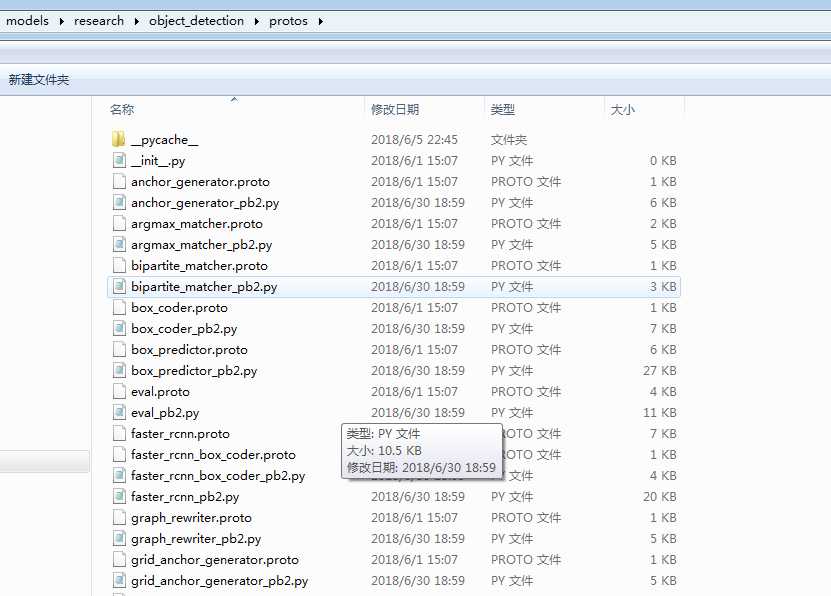
3、检查API是否正常
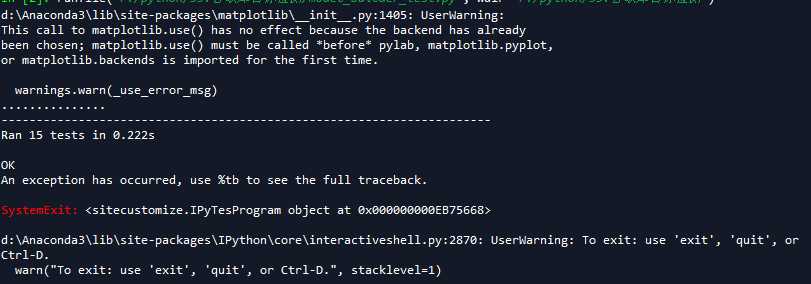
4、将Object Detection API加入Python库默认搜索路径

三 执行已经训练好的模型
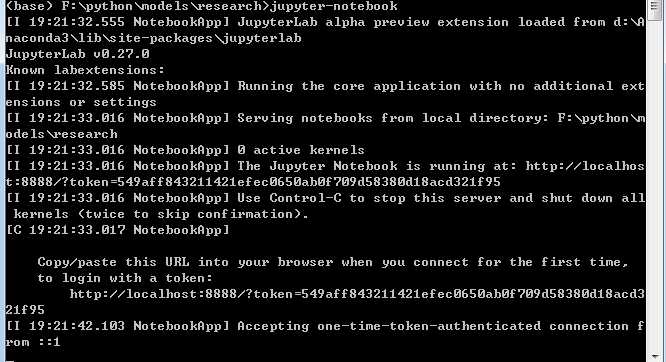

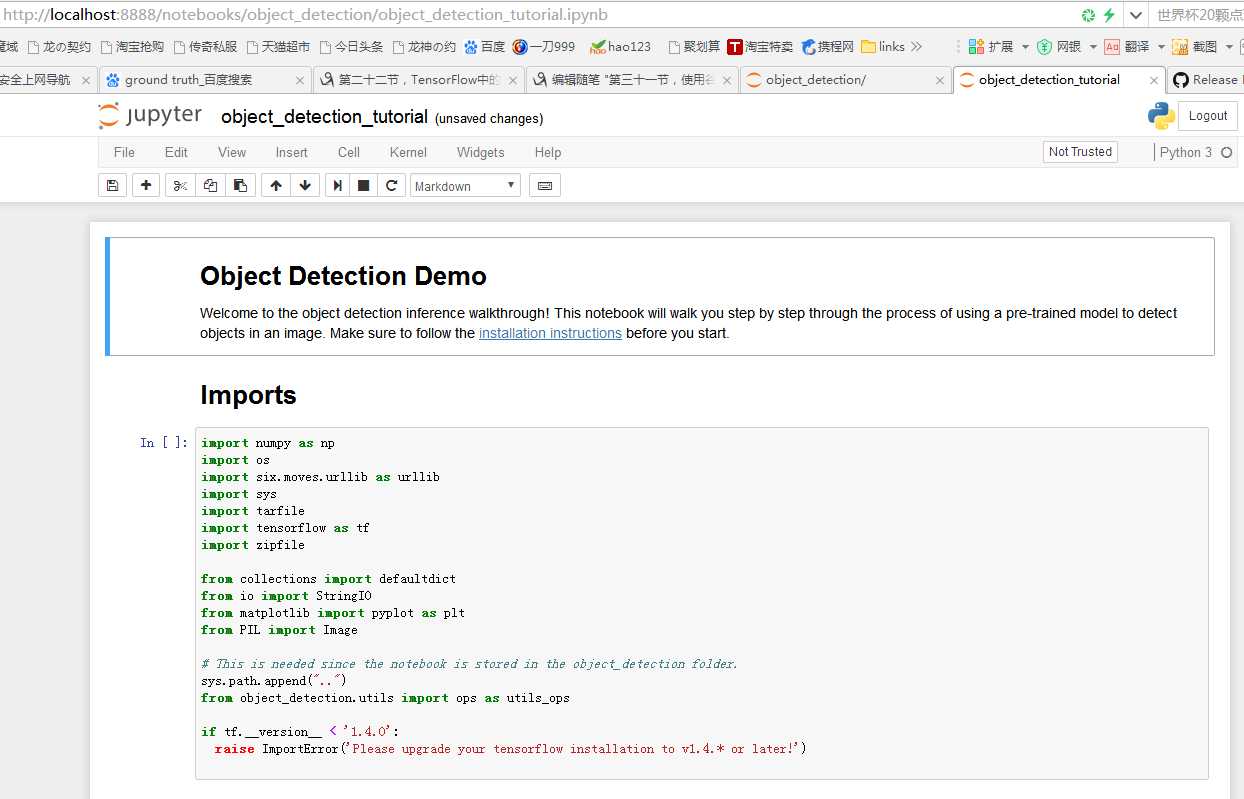
1、下载模型
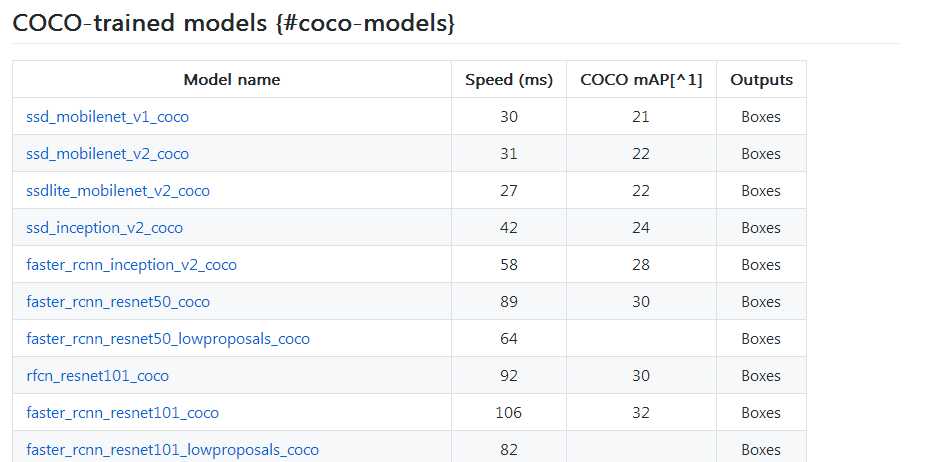
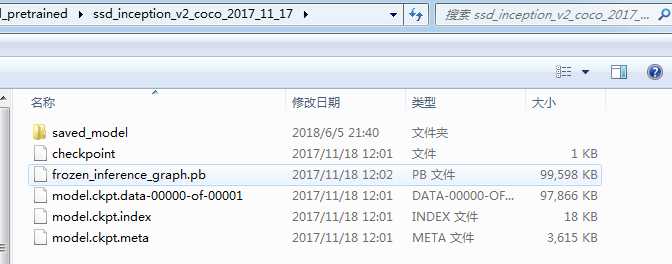
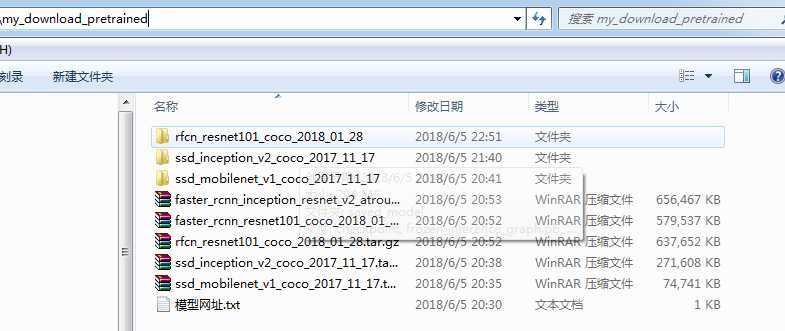
2.程序详解
# -*- coding: utf-8 -*-
"""
Created on Tue Jun 5 20:34:06 2018
@author: zy
"""
‘‘‘
调用Object Detection API进行实物检测 需要GPU运行环境,CPU下会报错
模型下载网址:https://github.com/tensorflow/models/blob/master/research/object_detection/g3doc/detection_model_zoo.md
TensorFlow 生成的 .ckpt 和 .pb 都有什么用?
https://www.cnblogs.com/nowornever-L/p/6991295.html
如何用Tensorflow训练模型成pb文件(一)——基于原始图片的读取
https://blog.csdn.net/u011463646/article/details/77918980?fps=1&locationNum=7
‘‘‘
import matplotlib.pyplot as plt
import numpy as np
import os
import tensorflow as tf
from object_detection.utils import label_map_util
from object_detection.utils import visualization_utils as vis_util
from PIL import Image
def test():
#重置图
tf.reset_default_graph()
‘‘‘
载入模型以及数据集样本标签,加载待测试的图片文件
‘‘‘
#指定要使用的模型的路径 包含图结构,以及参数
PATH_TO_CKPT = ‘./my_download_pretrained/ssd_mobilenet_v1_coco_2017_11_17/frozen_inference_graph.pb‘
#测试图片所在的路径
PATH_TO_TEST_IMAGES_DIR = ‘./object_detection/test_images‘
TEST_IMAGE_PATHS = [os.path.join(PATH_TO_TEST_IMAGES_DIR,‘image{}.jpg‘.format(i)) for i in range(1,3) ]
#数据集对应的label mscoco_label_map.pbtxt文件保存了index到类别名的映射
PATH_TO_LABELS = os.path.join(‘./object_detection/data‘,‘mscoco_label_map.pbtxt‘)
NUM_CLASSES = 90
#重新定义一个图
output_graph_def = tf.GraphDef()
with tf.gfile.GFile(PATH_TO_CKPT,‘rb‘) as fid:
#将*.pb文件读入serialized_graph
serialized_graph = fid.read()
#将serialized_graph的内容恢复到图中
output_graph_def.ParseFromString(serialized_graph)
#print(output_graph_def)
#将output_graph_def导入当前默认图中(加载模型)
tf.import_graph_def(output_graph_def,name=‘‘)
print(‘模型加载完成‘)
#载入coco数据集标签文件
label_map = label_map_util.load_labelmap(PATH_TO_LABELS)
categories = label_map_util.convert_label_map_to_categories(label_map,max_num_classes = NUM_CLASSES,use_display_name = True)
category_index = label_map_util.create_category_index(categories)
‘‘‘
定义session
‘‘‘
def load_image_into_numpy_array(image):
‘‘‘
将图片转换为ndarray数组的形式
‘‘‘
im_width,im_height = image.size
return np.array(image.getdata()).reshape((im_height,im_width,3)).astype(np.uint0)
#设置输出图片的大小
IMAGE_SIZE = (12,8)
#使用默认图,此时已经加载了模型
detection_graph = tf.get_default_graph()
with tf.Session(graph=detection_graph) as sess:
for image_path in TEST_IMAGE_PATHS:
image = Image.open(image_path)
#将图片转换为numpy格式
image_np = load_image_into_numpy_array(image)
‘‘‘
定义节点,运行并可视化
‘‘‘
#将图片扩展一维,最后进入神经网络的图片格式应该是[1,?,?,3]
image_np_expanded = np.expand_dims(image_np,axis = 0)
‘‘‘
获取模型中的tensor
‘‘‘
image_tensor = detection_graph.get_tensor_by_name(‘image_tensor:0‘)
#boxes用来显示识别结果
boxes = detection_graph.get_tensor_by_name(‘detection_boxes:0‘)
#Echo score代表识别出的物体与标签匹配的相似程度,在类型标签后面
scores = detection_graph.get_tensor_by_name(‘detection_scores:0‘)
classes = detection_graph.get_tensor_by_name(‘detection_classes:0‘)
num_detections = detection_graph.get_tensor_by_name(‘num_detections:0‘)
#开始检查
boxes,scores,classes,num_detections = sess.run([boxes,scores,classes,num_detections],
feed_dict={image_tensor:image_np_expanded})
#可视化结果
vis_util.visualize_boxes_and_labels_on_image_array(
image_np,
np.squeeze(boxes),
np.squeeze(classes).astype(np.int32),
np.squeeze(scores),
category_index,
use_normalized_coordinates=True,
line_thickness=8)
plt.figure(figsize=IMAGE_SIZE)
print(type(image_np))
print(image_np.shape)
image_np = np.array(image_np,dtype=np.uint8)
plt.imshow(image_np)
if __name__ == ‘__main__‘:
test()
四 训练新的模型
1、下载数据集

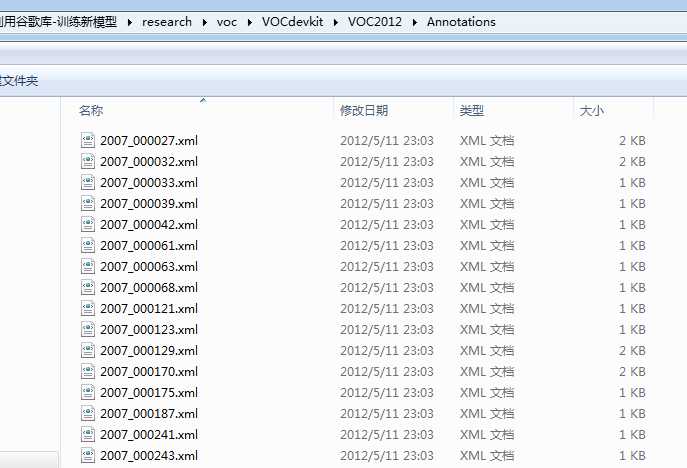
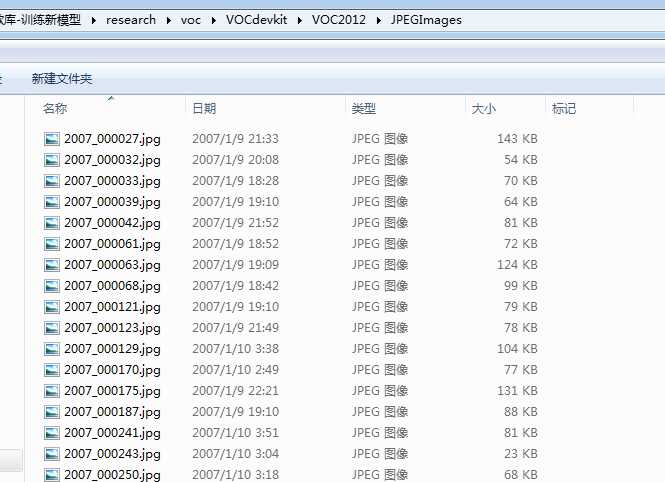
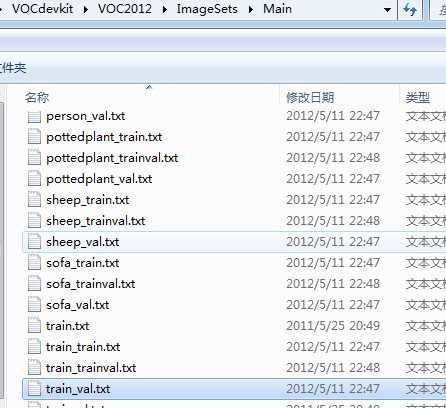
annotation>
folder>VOC2012folder>
filename>2007_000027.jpgfilename>
source>
database>The VOC2007 Databasedatabase>
annotation>PASCAL VOC2007annotation>
image>flickrimage>
source>
size>
width>486width>
height>500height>
depth>3depth>
size>
segmented>0segmented>
object>
name>personname>
pose>Unspecifiedpose>
truncated>0truncated>
difficult>0difficult>
bndbox>
xmin>174xmin>
ymin>101ymin>
xmax>349xmax>
ymax>351ymax>
bndbox>
part>
name>headname>
bndbox>
xmin>169xmin>
ymin>104ymin>
xmax>209xmax>
ymax>146ymax>
bndbox>
part>
part>
name>handname>
bndbox>
xmin>278xmin>
ymin>210ymin>
xmax>297xmax>
ymax>233ymax>
bndbox>
part>
part>
name>footname>
bndbox>
xmin>273xmin>
ymin>333ymin>
xmax>297xmax>
ymax>354ymax>
bndbox>
part>
part>
name>footname>
bndbox>
xmin>319xmin>
ymin>307ymin>
xmax>340xmax>
ymax>326ymax>
bndbox>
part>
object>
annotation>
2、生成tf文件
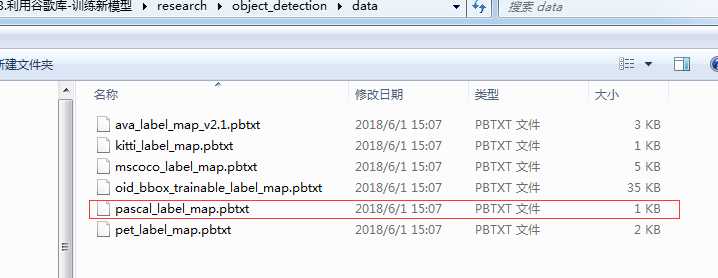


# Copyright 2017 The TensorFlow Authors. All Rights Reserved.
#
# Licensed under the Apache License, Version 2.0 (the "License");
# you may not use this file except in compliance with the License.
# You may obtain a copy of the License at
#
# http://www.apache.org/licenses/LICENSE-2.0
#
# Unless required by applicable law or agreed to in writing, software
# distributed under the License is distributed on an "AS IS" BASIS,
# WITHOUT WARRANTIES OR CONDITIONS OF ANY KIND, either express or implied.
# See the License for the specific language governing permissions and
# limitations under the License.
# ==============================================================================
r"""Convert raw PASCAL dataset to TFRecord for object_detection.
Example usage:
./create_pascal_tf_record --data_dir=/home/user/VOCdevkit --year=VOC2012 --output_path=/home/user/pascal.record
"""
from __future__ import absolute_import
from __future__ import division
from __future__ import print_function
import hashlib
import io
import logging
import os
from lxml import etree
import PIL.Image
import tensorflow as tf
from object_detection.utils import dataset_util
from object_detection.utils import label_map_util
import sys
#配置logging
logging.basicConfig(format=‘%(asctime)s %(levelname)s %(message)s‘,
level=logging.INFO,
stream=sys.stdout)
#命令行参数 主要包括数据集根目录,数据类型,输出tf文件路径等
flags = tf.app.flags
flags.DEFINE_string(‘data_dir‘, ‘‘, ‘Root directory to raw PASCAL VOC dataset.‘)
flags.DEFINE_string(‘set‘, ‘train‘, ‘Convert training set, validation set or ‘
‘merged set.‘)
flags.DEFINE_string(‘annotations_dir‘, ‘Annotations‘,
‘(Relative) path to annotations directory.‘)
flags.DEFINE_string(‘year‘, ‘VOC2007‘, ‘Desired challenge year.‘)
flags.DEFINE_string(‘output_path‘, ‘‘, ‘Path to output TFRecord‘)
flags.DEFINE_string(‘label_map_path‘, ‘voc/pascal_label_map.pbtxt‘,
‘Path to label map proto‘)
flags.DEFINE_boolean(‘ignore_difficult_instances‘, False, ‘Whether to ignore ‘
‘difficult instances‘)
FLAGS = flags.FLAGS
SETS = [‘train‘, ‘val‘, ‘trainval‘, ‘test‘]
YEARS = [‘VOC2007‘, ‘VOC2012‘, ‘merged‘]
def dict_to_tf_example(data,
dataset_directory,
label_map_dict,
ignore_difficult_instances=False,
image_subdirectory=‘JPEGImages‘):
"""Convert XML derived dict to tf.Example proto.
Notice that this function normalizes the bounding box coordinates provided
by the raw data.
Args:
data: dict holding PASCAL XML fields for a single image (obtained by
running dataset_util.recursive_parse_xml_to_dict)
dataset_directory: Path to root directory holding PASCAL dataset
label_map_dict: A map from string label names to integers ids.
ignore_difficult_instances: Whether to skip difficult instances in the
dataset (default: False).
image_subdirectory: String specifying subdirectory within the
PASCAL dataset directory holding the actual image data.
Returns:
example: The converted tf.Example.
Raises:
ValueError: if the image pointed to by data[‘filename‘] is not a valid JPEG
"""
#获取相对图片路径
img_path = os.path.join(data[‘folder‘], image_subdirectory, data[‘filename‘])
#获取图片绝对路径
full_path = os.path.join(dataset_directory, img_path)
#读取图片
with tf.gfile.GFile(full_path, ‘rb‘) as fid:
encoded_jpg = fid.read()
encoded_jpg_io = io.BytesIO(encoded_jpg)
image = PIL.Image.open(encoded_jpg_io)
if image.format != ‘JPEG‘:
raise ValueError(‘Image format not JPEG‘)
key = hashlib.sha256(encoded_jpg).hexdigest()
#获取图片的宽和高
width = int(data[‘size‘][‘width‘])
height = int(data[‘size‘][‘height‘])
xmin = []
ymin = []
xmax = []
ymax = []
classes = []
classes_text = []
truncated = []
poses = []
difficult_obj = []
for obj in data[‘object‘]:
#是否为难以辨识的物体, 主要指要结体背景才能判断出类别的物体。虽有标注, 但一般忽略这类物体 跳过难以识别的?
difficult = bool(int(obj[‘difficult‘]))
if ignore_difficult_instances and difficult:
continue
difficult_obj.append(int(difficult))
#bounding box 计算目标边界 归一化到[0,1]之间 左上角坐标,右下角坐标
xmin.append(float(obj[‘bndbox‘][‘xmin‘]) / width)
ymin.append(float(obj[‘bndbox‘][‘ymin‘]) / height)
xmax.append(float(obj[‘bndbox‘][‘xmax‘]) / width)
ymax.append(float(obj[‘bndbox‘][‘ymax‘]) / height)
#类别名
classes_text.append(obj[‘name‘].encode(‘utf8‘))
#获取该类别对应的标签
classes.append(label_map_dict[obj[‘name‘]])
#物体是否被部分遮挡
truncated.append(int(obj[‘truncated‘]))
#物体的姿势
poses.append(obj[‘pose‘].encode(‘utf8‘))
#tf文件一条记录格式
example = tf.train.Example(features=tf.train.Features(feature={
‘image/height‘: dataset_util.int64_feature(height),
‘image/width‘: dataset_util.int64_feature(width),
‘image/filename‘: dataset_util.bytes_feature(
data[‘filename‘].encode(‘utf8‘)),
‘image/source_id‘: dataset_util.bytes_feature(
data[‘filename‘].encode(‘utf8‘)),
‘image/key/sha256‘: dataset_util.bytes_feature(key.encode(‘utf8‘)),
‘image/encoded‘: dataset_util.bytes_feature(encoded_jpg),
‘image/format‘: dataset_util.bytes_feature(‘jpeg‘.encode(‘utf8‘)),
‘image/object/bbox/xmin‘: dataset_util.float_list_feature(xmin),
‘image/object/bbox/xmax‘: dataset_util.float_list_feature(xmax),
‘image/object/bbox/ymin‘: dataset_util.float_list_feature(ymin),
‘image/object/bbox/ymax‘: dataset_util.float_list_feature(ymax),
‘image/object/class/text‘: dataset_util.bytes_list_feature(classes_text),
‘image/object/class/label‘: dataset_util.int64_list_feature(classes),
‘image/object/difficult‘: dataset_util.int64_list_feature(difficult_obj),
‘image/object/truncated‘: dataset_util.int64_list_feature(truncated),
‘image/object/view‘: dataset_util.bytes_list_feature(poses),
}))
return example
def main(_):
‘‘‘
主要是通过读取VOCdevkit\VOC2012\Annotations下的xml文件
然后获取对应的图片文件的路径,图片大小,文件名,边界框、以及图片数据等信息写入rfrecord文件
‘‘‘
if FLAGS.set not in SETS:
raise ValueError(‘set must be in : {}‘.format(SETS))
if FLAGS.year not in YEARS:
raise ValueError(‘year must be in : {}‘.format(YEARS))
data_dir = FLAGS.data_dir
years = [‘VOC2007‘, ‘VOC2012‘]
if FLAGS.year != ‘merged‘:
years = [FLAGS.year]
#创建对象,用于向记录文件写入记录
writer = tf.python_io.TFRecordWriter(FLAGS.output_path)
#获取类别名->index的映射 dict类型
label_map_dict = label_map_util.get_label_map_dict(FLAGS.label_map_path)
for year in years:
logging.info(‘Reading from PASCAL %s dataset.‘, year)
#获取aeroplane_train.txt文件的全路径 改文件保存部分文件名(一共5717/5823个文件,各类图片都有)
examples_path = os.path.join(data_dir, year, ‘ImageSets‘, ‘Main‘,
‘aeroplane_‘ + FLAGS.set + ‘.txt‘)
#获取所有图片标注xml文件的路径
annotations_dir = os.path.join(data_dir, year, FLAGS.annotations_dir)
#list 存放文件名
examples_list = dataset_util.read_examples_list(examples_path)
#遍历annotations_dir目录下,examples_list中指定的xml文件
for idx, example in enumerate(examples_list):
if idx % 100 == 0:
logging.info(‘On image %d of %d‘, idx, len(examples_list))
path = os.path.join(annotations_dir, example + ‘.xml‘)
with tf.gfile.GFile(path, ‘r‘) as fid:
xml_str = fid.read()
xml = etree.fromstring(xml_str)
#获取annotation节点的内容
data = dataset_util.recursive_parse_xml_to_dict(xml)[‘annotation‘]
#把数据整理成tfrecord需要的数据结构
tf_example = dict_to_tf_example(data, FLAGS.data_dir, label_map_dict,
FLAGS.ignore_difficult_instances)
#向tf文件写入一条记录
writer.write(tf_example.SerializeToString())
writer.close()
if __name__ == ‘__main__‘:
tf.app.run()

python create_pascal_tf_record.py --data_dir voc/VOCdevkit --year=VOC2012 --set=train --output_path=voc/pascal_train.record
python create_pascal_tf_record.py --data_dir voc/VOCdevkit --year=VOC2012 --set=val --output_path=voc/pascal_val.record
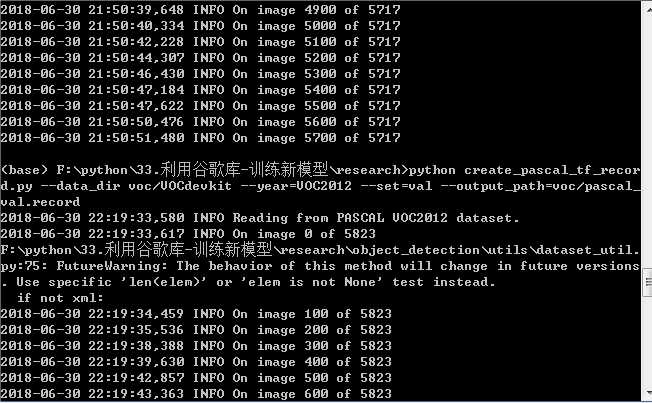
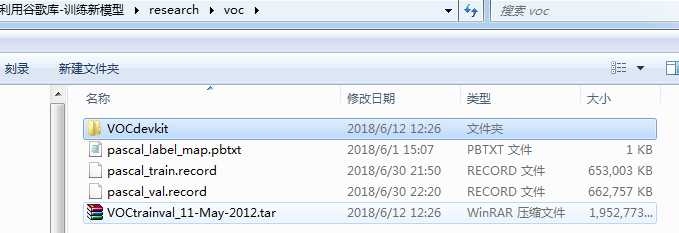
3、下载模型
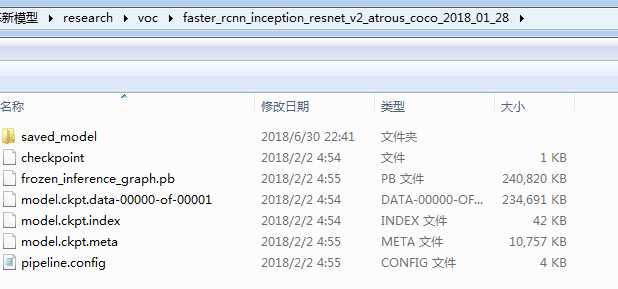
4、训练模型
gradient_clipping_by_norm: 10.0
fine_tune_checkpoint: "voc/faster_rcnn_inception_resnet_v2_atrous_coco_2018_01_28/model.ckpt"
from_detection_checkpoint: true
# Note: The below line limits the training process to 200K steps, which we
# empirically found to be sufficient enough to train the pets dataset. This
# effectively bypasses the learning rate schedule (the learning rate will
# never decay). Remove the below line to train indefinitely.
num_steps: 200000
data_augmentation_options {
random_horizontal_flip {
}
}
}
train_input_reader: {
tf_record_input_reader {
input_path: "voc/pascal_train.record"
}
label_map_path: "voc/pascal_label_map.pbtxt"
}
eval_config: {
num_examples: 5823
# Note: The below line limits the evaluation process to 10 evaluations.
# Remove the below line to evaluate indefinitely.
max_evals: 10
}
eval_input_reader: {
tf_record_input_reader {
input_path: "voc/pascal_val.record"
}
label_map_path: "voc/pascal_label_map.pbtxt"
shuffle: false
num_readers: 1
}
python train.py --train_dir voc/train_dir/ --pipeline_config_path voc/faster_rcnn_inception_resnet_v2_atrous_voc.config
参考文章:将数据集做成VOC2007格式用于Faster-RCNN训练
VOC数据集制作2——ImageSets\Main里的四个txt文件
Pascal VOC 数据集介绍
上一篇:C#反射
下一篇:原来C#可以直接写二进制数的
文章标题:第三十一节,使用谷歌Object Detection API进行目标检测
文章链接:http://soscw.com/essay/70669.html